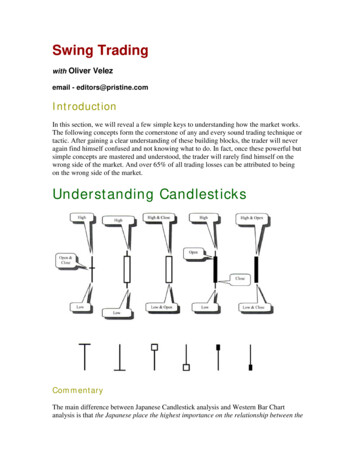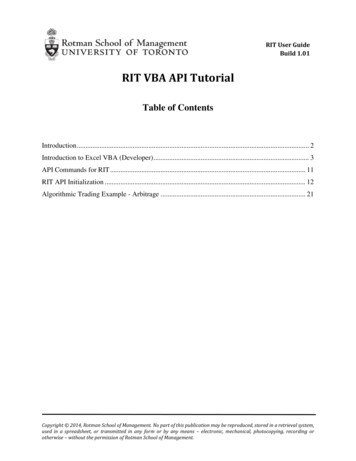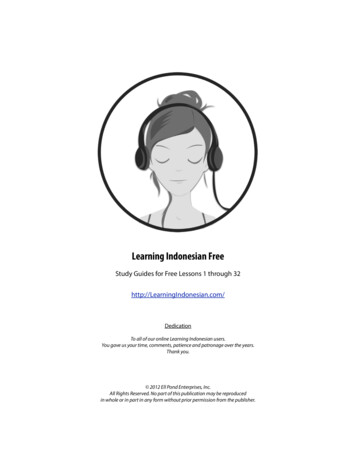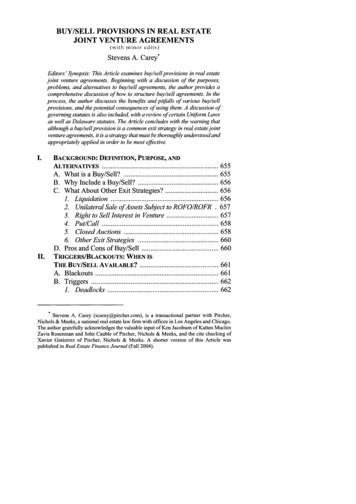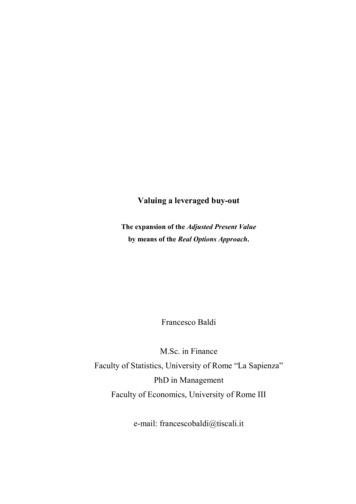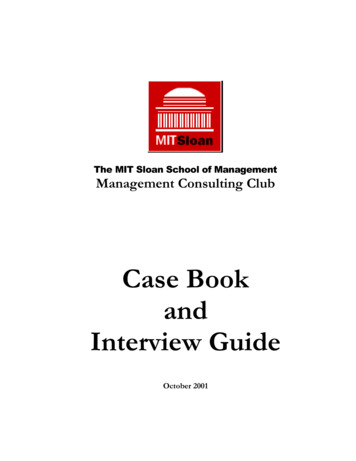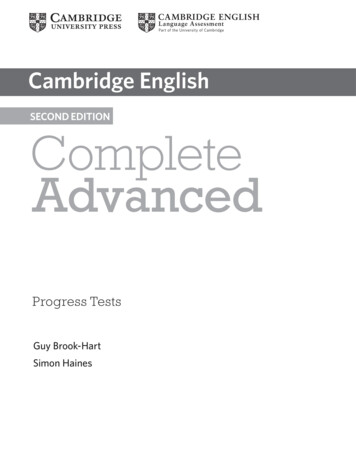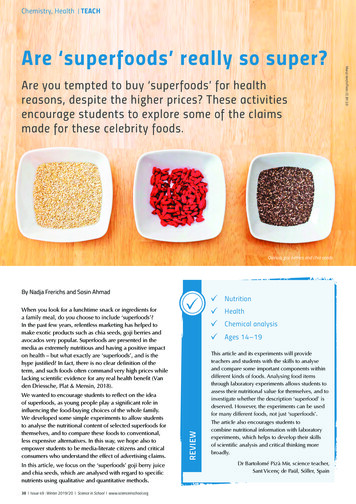
Transcription
Chemistry, Health TEACHAre you tempted to buy ‘superfoods’ for healthreasons, despite the higher prices? These activitiesencourage students to explore some of the claimsmade for these celebrity foods.Quinoa, goji berries and chia seedsBy Nadja Frerichs and Sosin AhmadNutritionHealthWhen you look for a lunchtime snack or ingredients fora family meal, do you choose to include ‘superfoods’?In the past few years, relentless marketing has helped tomake exotic products such as chia seeds, goji berries andavocados very popular. Superfoods are presented in themedia as extremely nutritious and having a positive impacton health – but what exactly are ‘superfoods’, and is thehype justified? In fact, there is no clear definition of theterm, and such foods often command very high prices whilelacking scientific evidence for any real health benefit (Vanden Driessche, Plat & Mensin, 2018).In this article, we focus on the ‘superfoods’ goji berry juiceand chia seeds, which are analysed with regard to specificnutrients using qualitative and quantitative methods.38 I Issue 49 : Winter 2019/20 I Science in School I www.scienceinschool.orgAges 14–19This article and its experiments will provideteachers and students with the skills to analyseand compare some important components withindifferent kinds of foods. Analysing food itemsthrough laboratory experiments allows students toassess their nutritional value for themselves, and toinvestigate whether the description ‘superfood’ isdeserved. However, the experiments can be usedfor many different foods, not just ‘superfoods’.REVIEWWe wanted to encourage students to reflect on the ideaof superfoods, as young people play a significant role ininfluencing the food-buying choices of the whole family.We developed some simple experiments to allow studentsto analyse the nutritional content of selected superfoods forthemselves, and to compare these foods to conventional,less expensive alternatives. In this way, we hope also toempower students to be media-literate citizens and criticalconsumers who understand the effect of advertising claims.Chemical analysisThe article also encourages students tocombine nutritional information with laboratoryexperiments, which helps to develop their skillsof scientific analysis and critical thinking morebroadly.Dr Bartolomé Pizà Mir, science teacher,Sant Vicenç de Paül, Sóller, SpainMarco Verch/Flickr, CC BY 2.0Are ‘superfoods’ really so super?
TEACH Chemistry, HealthBlueberriesCranberriesGoji berriesSeedsChia seedsHemp seedsQuinoaOtherGarlicGingerChilliesBee pollenSpirulinaWheat grassNadja FrerichsBerries3. Take out the test strip and wait foranother 30 seconds.4. Now compare the colour of the testfield with the scale on the packaging.What can you conclude?5. Carry out the test with the goji juicein the same way.Goji berry juice (left) and orange juice (right)Nadja FrerichsThe activities are suitable for studentsfrom around age 16, although thequantitative analysis may require somemore advanced knowledge of chemistry.Safety note: For all the experiments,students should wear safety glassesand follow the usual safety rules forchemistry classes.Vitamin C test strip and scale after immersion inorange juiceThis activity takes about 10 minutes.Materials· Orange juice· Goji berry juice· Two beakers (50 ml)· Ascorbic acid test strips (we usedthe Quantofix strips byMacherey-Nagel)ResultsThe test strip results show theapproximate concentration of vitaminC in each juice. In the orange juice,the test strip turns green, showingthat this juice contains quite a highconcentration of vitamin C, so it is agood source of this vitamin. Goji juicemakes the test strip turn a darker green,showing that this juice contains morevitamin C than orange juice.In the next activity, students use atitration method to measure the vitaminC concentration in each juice accuratelyand compare this to the recommendeddaily requirement.Nadja FrerichsGoji berries and their juice are oftenassociated with an extremely highvitamin C content. But is drinkinggoji berry juice better than the goodold habit of a glass of orange juice forbreakfast, given that the goji juice ismuch more expensive? In this activity,the ascorbic acid (vitamin C) contentof the two juices is compared in aqualitative way using ascorbic acidtest strips.1. Put about 20 ml of the orangejuice into one beaker, and a similaramount of goji juice into the otherbeaker.2. Take an ascorbic acid test strip andhold it in the orange juice for about10 seconds. Make sure that the testfield is completely submerged in theliquid.Table 1: List of some foods commonly described as‘superfoods’Activity 1: Comparing gojiberry juice and orange juiceProcedureVitamin C test strip and scale after immersion in gojiberry juiceActivity 2: Quantitativeanalysis of vitamin C in juiceFrom activity 1 we know that both gojiberry juice and orange juice containvitamin C – but which juice is a betterchoice to meet our daily need forvitamin C?Titration with 2,6-dichlorphenolin dophenol sodium solution is a commonprocedure to detect the amount ofascorbic acid. One mole of (anhydrous)2,6-dichlorphenolindophenol sodiumreacts with one mole of ascorbic acid,and the solution changes initially fromlight blue to colourless, and then fromcolourless back to light blue at theend point (once all the ascorbic acidhas reacted). As the ascorbic acid isconstantly oxidised by oxygen in the air,oxalic acid is added to prevent this.www.scienceinschool.org I Science in School I Issue 49 : Winter 2019/20 I 39
Chemistry, Health TEACHNadja FrerichsThis activity takes about 45 minutes(plus 15 minutes of preparation time forthe solutions).Materials· Orange juiceCalculation for orange juice:· Goji berry juiceVtotal V1 – V2· Oxalic acid solution (2% w/w) 50 ml – 22 ml 28 mlHere, one mole of 2,6dichlorophenolindophenol sodiumreacts with one mole of ascorbic acid.· 2,6 dichlorophenolindophenolsodium solution (0.001 mol/l)· Measuring cylinders (two 10 ml andone 20 ml)Thus, 1 ml of the 0.001M2,6-dichlorophenolindophenol sodiumsolution reacts with 0.176 mg ofascorbic acid (relative molecular massof ascorbic acid 176).· Beakers (100 ml)· Burette (secured with a clamp stand)· Funnel· Magnetic plate with a stirrerThe burette set up for the titration with orange juiceNadja FrerichsProcedure1. Place 50 ml of the2,6-dichlorophenolindophenolsodium solution in the burette.This is for 10 ml of juice, so 100 mlof orange juice contains 49.3 mg ofvitamin C.Calculation for goji berry juice:3. Place the flask and contents on themagnetic plate, so that the buretteopening is just above the beaker.Switch on the stirrer.Vtotal V1 – V2 70 ml – 12 ml 58 mlThus, 1 ml of the 0.001M2,6-dichlorophenolindophenol sodiumsolution reacts with 0.176 mg ofascorbic acid.4. Note the volume of the solution inthe burette (V1), then slowly andcarefully open the burette and startthe titration.So 58 ml of the 0.001M2,6-dichlorophenolindophenol sodiumsolution reacts with 0.176 mg x 58 ofascorbic acidCarrying out the titration with orange juiceNadja Frerichs6. Carry out the same steps with the gojiberry juice. You may need to refillthe burette before the end point isreached. 10.21 mgThis is for 10 ml of juice, so 100 ml ofgoji berry juice contains 102.1 mg ofvitamin C.For a large glass (300 ml) of each juice,the amount of vitamin C is:7. After the experiment, the solutionsshould be disposed of in a sealedcontainer for solutions containingorganic compounds.Orange: 49.3 x 3 147.9 mgGoji berry: 102.1 x 3 306.3 mgDiscussionCalculationIn this calculation, we work out howmuch vitamin C is in 100 ml of eachjuice (enough for a small glass).In our experiments, we found that 28 mlof 2,6-dichlorophenolindophenol sodiumsolution was needed to react with 10 mlSo 28 ml of the 0.001M2,6-dichlorophenolindophenol sodiumsolution reacts with 0.176 mg x 28 ofascorbic acid 4.93 mg2. Use the funnel and measuringcylinders to pour 10 ml of orangejuice, 20 ml of oxalic acid solutionand the stirrer into a beaker.5. As soon as you see a colour changein the flask, stop the titration andnote the volume of solution in theburette again; this is V2.of orange juice, and 58 ml was neededto react with 10 ml of goji berry juice.In the calculation below, we use thesefigures as examples, but students shouldreplace these figures with those fromtheir own experimental results.Colour change at the end point of the orange juicetitration40 I Issue 49 : Winter 2019/20 I Science in School I www.scienceinschool.orgIn Germany, one litre of goji berry juicecosts around 15, while orange juiceis available for less than 1 per litre.The daily need for vitamin C is about75–100 mg (depending on age, weight,and other factors). A large glass (300 ml)of orange juice has about 150 mg of
TEACH Chemistry, HealthNadja Frerichsvitamin C, which is already some 30%more than the daily requirement. So, itis not necessary to drink goji berry juicefor its even greater amount of vitamin C.Of course, other positive effects of gojiberry juice have been suggested, suchas the antioxidative effect, but so farthese benefits have not been establishedin humans (Kulczyński & GramzaMichałowska, 2016).Activity 3: Detectingproteins in seedsThis activity compares the proteincontent of linseeds (flax seeds) with‘superfood’ chia seeds.Chia seeds (left) and linseeds (right) after grindingProteins are an important part of abalanced diet, especially for peoplewith an active lifestyle. There are many‘high-protein’ products on the market –for example, breakfast cereals enrichedwith linseeds or the much moreexpensive chia seeds. Do these productsreally contribute to a protein-rich diet?2. Put the crushed seeds into separatetest tubes and add 5 ml of distilledwater to each.Results and discussionThe expected results are shown intable 2.3. Seal the test tubes with the stoppersand shake them well.4. Pour 5 ml of milk into the third testtube and 5 ml of distilled water intothe fourth test tube.Test tube contentsColour changeMilk (control)PurpleThis activity uses the biuret reactionto test for the presence of protein. Inthe reaction, a purple colour is seenwhen protein is present, due to copperions forming a coloured complex withproteins.5. Add 10 drops of the copper(II) sulfatesolution to each of the four test tubes.Water (control)Light blue6. Pipette 1 ml of sodium hydroxidesolution into each test tube.Chia seedsPurple7. Shake the test tubes to mix thecontents well.Linseeds, flax seedsPurpleThe activity takes about 30 minutes,plus 15 minutes of preparation time forthe solutions.8. Note your observations: you shouldsee some colour changes.Table 2: Expected results of the biuret test with chiaseeds and flax seeds9. After the experiment, dispose of thesolutions in a sealed container forsolutions containing heavy metals.Milk contains protein, so the milksolution turns purple. The chia seedMaterials· Chia seeds· Milk (as control)· Distilled waterNadja FrerichsNadja Frerichs· Linseeds (flax seeds)· Sodium hydroxide solution (1 mol/l)· Copper(II) sulfate solution (7% w/w)· Weighing scales· Test tube stand and 4 test tubes withstoppers· 2 pipettes (5 ml)· Dripping pipette· 2 x mortar and pestleProcedure1. Weigh out 0.5 g each of chia seedsand flax seeds, and grind these upseparately using the mortars andpestles.Test tubes with (from left) chia seeds, linseeds,milk, waterColour change after adding copper(II) sulfatesolution to chia seeds (left) and linseeds (right)www.scienceinschool.org I Science in School I Issue 49 : Winter 2019/20 I 41
Chemistry, Health TEACHNadja FrerichsNadja Frerichsquestion of sustainable nutrition, and toeducation for sustainable development.ReferencesEgras AM et al. (2011) An evidence-based reviewof fat modifying supplemental weight lossproducts. Journal of Obesity 2011: 297315.doi: 10.1155/2011/297315Kulczyński B, Gramza-Michałowska A (2016)Goji berry (Lycium barbarum): compositionand health effects – a review. Polish Journalof Food and Nutrition Sciences 66: 67-75. doi:10.1515/pjfns-2015-0040Chia seeds (left) and linseeds (right) on sale in a German supermarket, showing the price differencemost superfoods,“noForstudieson humansconfirm the potentialhealth benefits.”and linseed mixtures also turn purple,so both types of seed must also containprotein. Students may notice that thepurple coloration is more intense inthe chia sample, showing that theseseeds contain a higher concentration ofprotein.Proteins can improve muscle growthand contribute to a balanced diet, butis it necessary to pay more for chiaseeds? Note that the recommendeddaily amount of protein for an adult isaround 0.8–1 g per kg of body weight(Rodriguez, 2015) – that is, around 48 gper day for a 60 kg person. So, at thesequantities, it is quite easy for anyone toconsume enough protein just by eatinga balanced diet including normal foodsthat are rich in protein.Chia seeds are also thought to beextremely healthy due to othernutrients, especially unsaturated fats.In addition, in the media you can findadvice that eating chia seeds producesa feeling of being full for longer, andtherefore potentially helps weight loss,because the seeds expand when putinto liquid, producing a gelatinous ‘chiapudding’. However, so far, no studiesconfirm either the nutritional benefitsor the weight loss effects of chia seeds(Ulbricht et al., 2009; Egras et al.,2011).ConclusionsFrom the results of these experimentsthe students can conclude that, inmany cases, non-exotic, less expensive,perhaps locally sourced alternativesmay be quite sufficient to meet thedaily needs for nutrients and maintaina healthy diet. For most superfoods, nostudies on humans confirm the potentialhealth benefits. Rather, a diet that isbalanced overall is the key to healthynutritional habits.The activities could be followed up bya classroom discussion on the ethicaland ecological aspects of superfoods.For example, the excessive cultivationof avocados leads to huge amountsof pesticides being released to theenvironment, and long transportationroutes from South America impactthe environment. A social aspect isthat the popularity of certain products(e.g. quinoa) in developed countriesleads to rising prices in their countriesof origin (in this case mostly Chileand Bolivia), where people are nolonger able to afford their staple foods.Such discussions could lead to the42 I Issue 49 : Winter 2019/20 I Science in School I www.scienceinschool.orgRodriguez NR (2015) Introduction to ProteinSummit 2.0: continued exploration of theimpact of high-quality protein on optimalhealth. The American Journal of ClinicalNutrition 101: 1317S-1319S. doi: 10.3945/ajcn.114.083980Ulbricht C et al. (2009) Chia (Salvia hispanica):a systematic review by the NaturalStandard Research Collaboration. Reviewson Recent Clinical Trials 4(3): 168-174. doi:10.2174/157488709789957709van den Driessche JJ, Plat J, Mensink RP (2018)Effects of superfoods on risk factors ofmetabolic syndrome: a systematic review ofhuman intervention trials. Food & Function 9:1944-1966. doi: 10.1039/C7FO01792HResourcesA comprehensive and accessible overview ofsuperfoods from the Harvard T H ChanSchool of Public Health can help sparkclassroom discussion. See: www.hsph.harvard.edu/nutritionsource/superfoods/An article from the Harvard Medical Schoolhighlights some less exotic foods thatcan provide some important nutrients toenhance a healthy diet. See: a-healthy-diet-2018082914463Dr Nadja Frerichs is a postdoctoralresearcher in the Department ofChemistry Education, Institute forScience Education (IDN) at theUniversity of Bremen and also a teacherat a secondary school in Bremen,Germany. Her research focuses onscientific media literacy and curriculuminnovations.Sosin Ahmad is a Master of Educationstudent of chemistry and mathematics atthe University of Bremen. Her bachelorthesis dealt with the chemistry ofselected superfoods.
of superfoods, as young people play a significant role in influencing the food-buying choices of the whole family. We developed some simple experiments to allow students to analyse the nutritional content of selected superfoods for themselves, and to compare these foods to conventional,
